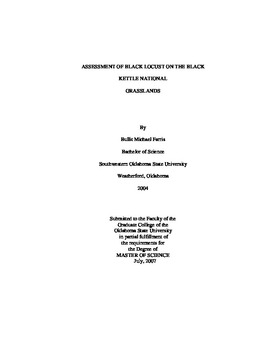| dc.contributor.advisor | Caneday, Lowell | |
| dc.contributor.author | Farris, Bullit Michael | |
| dc.date.accessioned | 2014-04-15T22:31:40Z | |
| dc.date.available | 2014-04-15T22:31:40Z | |
| dc.date.issued | 2007-07-01 | |
| dc.identifier.uri | https://hdl.handle.net/11244/9554 | |
| dc.description.abstract | The expansion of woody species in savannah and savannah-like ecosystems has greatly increased in the last several decades and has become a worldwide issue. Woody encroachment may lead to the displacement of wildlife species that depend on open grasslands, decrease species diversity, disrupt natural disturbance regimes, alter water/energy cycles, and reduce amount of grazing lands available for livestock. Rows of black locust trees were planted along fence lines of what is now the Black Kettle National Grasslands following the Dust Bowl period as an erosion preventative and now these trees are encroaching on areas of native and replanted prairie. Remote sensing combined with GIS analysis has been established as one of the most effective ways to study the conversion of grasslands to forests and has been used in many parts of the world to analyze woody encroachment. The purpose of this study is to analyze the distribution of black locust in the Black Kettle National Grasslands by comparing historical and current stand area using aerial photography and investigate the differences in encroachment rates focusing on the influence of potential soil moisture content using the topographic wetness index. Total area of black locust in 1966 was 188.96 ha and the total current area was 580.07 ha. Black locust populations on Black Kettle National Grasslands have shown a substantial amount of growth beyond their original plantings beginning in the late 1930's. Increased soil moisture due to topography is not the primary driver of black locust encroachment and is also likely influenced by a combination of disturbance regimes, competition, soil characteristics, and land use history. | |
| dc.format | application/pdf | |
| dc.language | en_US | |
| dc.publisher | Oklahoma State University | |
| dc.rights | Copyright is held by the author who has granted the Oklahoma State University Library the non-exclusive right to share this material in its institutional repository. Contact Digital Library Services at lib-dls@okstate.edu or 405-744-9161 for the permission policy on the use, reproduction or distribution of this material. | |
| dc.title | Assessment of Black Locust on the Black Kettle National Grasslands | |
| dc.type | text | |
| dc.contributor.committeeMember | Rao, Mahesh | |
| dc.contributor.committeeMember | Baum, Kristen | |
| osu.filename | Farris_okstate_0664M_2402.pdf | |
| osu.college | Agricultural Sciences and Natural Resources | |
| osu.accesstype | Open Access | |
| dc.description.department | Environmental Sciences Program | |
| dc.type.genre | Thesis | |
| dc.subject.keywords | black locust | |
| dc.subject.keywords | woody encroachment | |
| dc.subject.keywords | aerial photography | |
| dc.subject.keywords | geographic information systems | |
